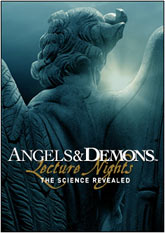

Tuesday - May 19, 2009
SLAC Today is
available online at:
http://today.slac.stanford.edu
In this issue:
SLUO Members Go to Washington
Watch That Laptop, Part 2 of 2: Travel Requirements
Live Today: The Science of Angels & Demons
Special SLAC/Stanford Colloquium Today
 |
 |
|
Tuesday - May 19, 2009 |
SLUO Members Go to WashingtonMembers of the SLAC Users Organization. Front row, left to right: Gerard Bonneaud, David Doll, Norman Graf. Back row, left to right: Steve Sekula, Bill Lockman, David Miller (also U.S. LHC), Michael Busha. Not pictured: Sarah Demers (also U.S. LHC), Gregory Dubois-Felsmann, Brian Gerke, Tom Handler, Lisa Kaufman
and Greg Madejski.
April 28–May 1, a group of 49 volunteers from the user organizations of SLAC, Fermilab and the U.S. LHC team traveled to Washington D.C. The scientists visited more than 200 congressional offices and met with the leaderships of the National Science Foundation Physics Division, the Department of Energy Office of Science, as well as with the President's Office of Management and Budget. They brought a message of thanks to Congress, for this year's attention to basic research in the physical sciences in both the federal budget and the American Recovery and Reinvestment Act. They also brought a message about the importance of science to the nation and the role of particle and astrophysics in the U.S. scientific portfolio. The visits aimed to raise the visibility of basic research efforts at DOE and NSF, as well as encourage Congress to continue on the path of growth for the science investment. In return, the participants received several messages to be transmitted back to the user communities. Read more... 
Live Today: The Science of Angels & DemonsOn May 15, 2009, Sony Pictures released Angels & Demons, bringing the world's largest particle physics laboratory to the silver screen. Fans of science can watch a teleconference about the science of the film live at the National Science Foundation's Science360 Web site today, Tuesday, May 19, at 1 p.m. U.S. EDT, or 7 p.m. Central European Standard Time. Read more in Symmetry Breaking... Reminder: Watch That LaptopPart 2 of 2: Travel RequirementsThis is the second of two articles on laptop security and procedures. See also Part 1 of 2: Protecting Government Equipment. If you are taking your laptop off-site for official use—whether taking it home each day or to a conference or seminar—special requirements apply. First, you must have a current Offsite Use form. Forms are valid up to one year and must be renewed annually. If you suspect that a theft of government property has occurred off-site, you must file a report with local law enforcement as soon as possible. Never store any Personally Identifiable Information on your laptop or other memory devices. If you have any reason to suspect any PII has been lost or compromised you must immediately report this to SLAC Security (x5555). Calling this one central number ensures that all required notifications are handled quickly. Finally, international travel with your SLAC-owned laptop, PDA, cell phone and/or any other digital storage device requires completion of the SLAC Annual TMP Form. (SUNet ID required.) Questions regarding export control should be directed to University Export Control Officer Steve Eisner. See the SLAC Laptop Security page for full current requirements and forms. Special SLAC/Stanford Colloquium TodayToday at 4:15 p.m. in Panofsky Auditorium, Leonardo Senatore of the Institute for Advanced Study will present "Non-Gaussianities: Probing High Energy Physics with Cosmological Observations." Observational cosmology has made tremendous progress in the last few years, allowing researchers to begin to understand what occurred in the very first few moments of the history of the Universe and how today's astrophysical structures developed. So far, all cosmological observations can be explained by assuming that the earliest perturbations, which grew into today's structures, followed a Gaussian ("bell curve") probability distribution, as predicted by the simplest class of inflationary models. As observations keep improving, they could soon show that their distribution is actually non-Gaussian. Senatore will explain how this could be detected, its theoretical motivation, and most importantly the large amount of information it would reveal us about the physics of the very early Universe. |
Events
Access (see all)
Announcements
|
|
| | ||
|
|
||
 <%
Response.AddHeader "Last-modified", getArticleDate()
'Response.AddHeader "Last-modified","Mon, 01 Sep 1997 01:03:33 GMT"
'Monday, December 06, 2010
%>
<%
Response.AddHeader "Last-modified", getArticleDate()
'Response.AddHeader "Last-modified","Mon, 01 Sep 1997 01:03:33 GMT"
'Monday, December 06, 2010
%>View online at http://today.slac.stanford.edu/. |
||